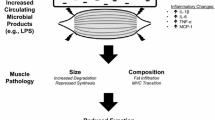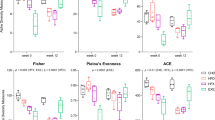Abstract
Intestinal barrier dysfunction leads to microbial translocation (MT) and inflammation in vertebrate and invertebrate animal models. Age is recently recognized as a factor leading to MT, and in some human and animal model studies, MT was associated with physical function. We evaluated sarcopenia, inflammation, MT biomarkers, and muscle insulin sensitivity in healthy female vervet monkeys (6–27 years old). Monkeys were fed consistent diets and had large and varied environments to facilitate physical activity, and stable social conditions. Aging led to sarcopenia as indicated by reduced walking speeds and muscle mass, but general metabolic health was similar in older monkeys (n = 25) as compared to younger ones (n = 26). When older monkeys were physically active, their MT burden approximated that in young monkeys; however, when older monkeys were sedentary, MT burden was dramatically increased. MT levels were positively associated with inflammatory burden and negatively associated with skeletal muscle insulin sensitivity. Time spent being active was positively associated with insulin sensitivity as expected, but this relationship was specifically modified by the individual monkey’s MT, not inflammatory burden. Our data supports clinical observations that MT interacts with physical function as a factor in healthy aging.



Similar content being viewed by others
References
Amar J et al. (2011) Intestinal mucosal adherence and translocation of commensal bacteria at the early onset of type 2 diabetes: molecular mechanisms and probiotic treatment. EMBO Mol Med 3:559–572
Atzmon G et al. (2004) Clinical phenotype of families with longevity. J Am Geriatr Soc 52:274–277
Balzan S, de Almeida Quadros C, de Cleva R, Zilberstein B, Cecconello I (2007) Bacterial translocation: overview of mechanisms and clinical impact. J Gastroenterol Hepatol 22:464–471
Bapat SP et al. (2015) Depletion of fat-resident Treg cells prevents age-associated insulin resistance. Nature 528:137–141
Brown-Borg HM, Bartke A (2012) GH and IGF1: roles in energy metabolism of long-living GH mutant mice. J Gerontol A Biol Sci Med Sci 67:652–660
Cani PD et al. (2007) Metabolic endotoxemia initiates obesity and insulin resistance. Diabetes 56:1761–1772
Cani PD et al. (2008) Changes in gut microbiota control metabolic endotoxemia-induced inflammation in high-fat diet-induced obesity and diabetes in mice. Diabetes 57:1470–1481
Chichester L, Gee MK, Jorgensen MJ, Kaplan JR (2015) Hematology and clinical chemistry measures during and after pregnancy and age- and sex-specific reference intervals in African green monkeys (Chlorocebus aethiops sabaeus). J Am Assoc Lab Anim Sci: JAALAS 54:359–367
Choi SJ et al. (2012) Force-generation capacity of single vastus lateralis muscle fibers and physical function decline with age in African green vervet monkeys. J Gerontol A Biol Sci Med Sci 68:258–267
Claesson MJ et al. (2011) Composition, variability, and temporal stability of the intestinal microbiota of the elderly. Proc Natl Acad Sci U S A 108(Suppl 1):4586–4591
Claesson MJ et al. (2012) Gut microbiota composition correlates with diet and health in the elderly. Nature 488:178–184
Cruz-Jentoft AJ et al. (2010) Sarcopenia: European consensus on definition and diagnosis: report of the European working group on sarcopenia in older people. Age Ageing 39:412–423
DeFronzo RA, Tobin JD, Andres R (1979) Glucose clamp technique: a method for quantifying insulin secretion and resistance. Am J Phys 237:E214–E223
Fry CS et al. (2011) Aging impairs contraction-induced human skeletal muscle mTORC1 signaling and protein synthesis. Skelet Muscle 1:11
Ghosh S et al. (2014) Elevated muscle TLR4 expression and metabolic endotoxemia in human aging. J Gerontol A Biol Sci Med Sci 70:232–246
Ghosh S et al. (2015) Elevated muscle TLR4 expression and metabolic endotoxemia in human aging. J Gerontol A Biol Sci Med Sci 70:232–246
Gibbons DL, Spencer J (2011) Mouse and human intestinal immunity: same ballpark, different players; different rules, same score. Mucosal Immunol 4:148–157
Haberthur K, Engelman F, Barron A, Messaoudi I (2010) Immune senescence in aged nonhuman primates. Exp Gerontol 45:655–661
Hallal PC et al. (2012) Global physical activity levels: surveillance progress, pitfalls, and prospects. Lancet 380:247–257
Kavanagh K et al. (2007a) Characterization and heritability of obesity and associated risk factors in vervet monkeys. Obesity (Silver Spring) 15:1666–1674
Kavanagh K et al. (2007b) Trans fat diet induces abdominal obesity and changes in insulin sensitivity in monkeys. Obesity (Silver Spring) 15:1675–1684
Kelly CJ, Colgan SP, Frank DN (2012) Of microbes and meals: the health consequences of dietary endotoxemia. Nutr Clin Pract 27:215–225
Levine ME, Crimmins EM (2012) The impact of insulin resistance and inflammation on the association between sarcopenic obesity and physical functioning. Obesity (Silver Spring) 20:2101–2106
Liang H, Hussey SE, Sanchez-Avila A, Tantiwong P, Musi N (2013) Effect of lipopolysaccharide on inflammation and insulin action in human muscle. PLoS One 8:e63983
Ma TY, Hollander D, Dadufalza V, Krugliak P (1992) Effect of aging and caloric restriction on intestinal permeability. Exp Gerontol 27:321–333
Mitchell EL et al. (2016) Reduced intestinal motility, mucosal barrier function, and inflammation in aged monkeys. J Nutr Health Aging. doi:10.1007/s12603-016-0725-y
Moreno-Navarrete JM et al. (2012) Circulating lipopolysaccharide-binding protein (LBP) as a marker of obesity-related insulin resistance. Int J Obes 36:1442–1449
Ogawa K, Sanada K, Machida S, Okutsu M, Suzuki K (2010) Resistance exercise training-induced muscle hypertrophy was associated with reduction of inflammatory markers in elderly women. Mediat Inflamm 2010:171023
Oliveira AG et al. (2011) Physical exercise reduces circulating lipopolysaccharide and TLR4 activation and improves insulin signaling in tissues of DIO rats. Diabetes 60:784–796
Reiner AP et al. (2013) Soluble CD14: genomewide association analysis and relationship to cardiovascular risk and mortality in older adults. Arterioscler Thromb Vasc Biol 33:158–164
Rera M, Clark RI, Walker DW (2012) Intestinal barrier dysfunction links metabolic and inflammatory markers of aging to death in Drosophila. Proc Natl Acad Sci U S A 109:21528–21533
Rodriguez-Miguelez P et al. (2015) Whole-body vibration improves the anti-inflammatory status in elderly subjects through toll-like receptor 2 and 4 signaling pathways. Mech Ageing Dev 150:12–19
Srikanthan P, Karlamangla AS (2011) Relative muscle mass is inversely associated with insulin resistance and prediabetes. Findings from the third National Health and Nutrition Examination Survey. J Clin Endocrinol Metab 96:2898–2903
Stehle JR Jr et al. (2012) Lipopolysaccharide-binding protein, a surrogate marker of microbial translocation, is associated with physical function in healthy older adults. J Gerontol A Biol Sci Med Sci 67:1212–1218
Timmerman KL et al. (2010) Insulin stimulates human skeletal muscle protein synthesis via an indirect mechanism involving endothelial-dependent vasodilation and mammalian target of rapamycin complex 1 signaling. J Clin Endocrinol Metab 95:3848–3857
Tran L, Greenwood-Van Meerveld B (2013) Age-associated remodeling of the intestinal epithelial barrier. J Gerontol A Biol Sci Med Sci 68:1045–1056
Ulgherait M, Rana A, Rera M, Graniel J, Walker DW (2014) AMPK modulates tissue and organismal aging in a non-cell-autonomous manner. Cell Rep 8:1767–1780
Vasilaki A, Jackson MJ (2013) Role of reactive oxygen species in the defective regeneration seen in aging muscle. Free Radic Biol Med 65C:317–323
Washburn RA et al. (2014) Does increased prescribed exercise alter non-exercise physical activity/energy expenditure in healthy adults? A systematic review. Clin Obes 4:1–20
Wernstedt Asterholm I et al. (2014) Adipocyte inflammation is essential for healthy adipose tissue expansion and remodeling. Cell Metab 20:103–118
Acknowledgments
This work was supported by the National Institute of Aging R21AG049160 (K.K), National Institutes of Health Office of the Director (P40OD010965 and T35OD010946 (K.K.), and Wake Forest School of Medicine.
Author information
Authors and Affiliations
Corresponding author
Ethics declarations
All study procedures were approved by and performed in accordance with the Wake Forest University Institutional Animal Care and Use Committee.
Electronic supplementary material
ESM 1
(DOCX 87 kb)
About this article
Cite this article
Kavanagh, K., Brown, R.N., Davis, A.T. et al. Microbial translocation and skeletal muscle in young and old vervet monkeys. AGE 38, 58 (2016). https://doi.org/10.1007/s11357-016-9924-z
Received:
Accepted:
Published:
DOI: https://doi.org/10.1007/s11357-016-9924-z




